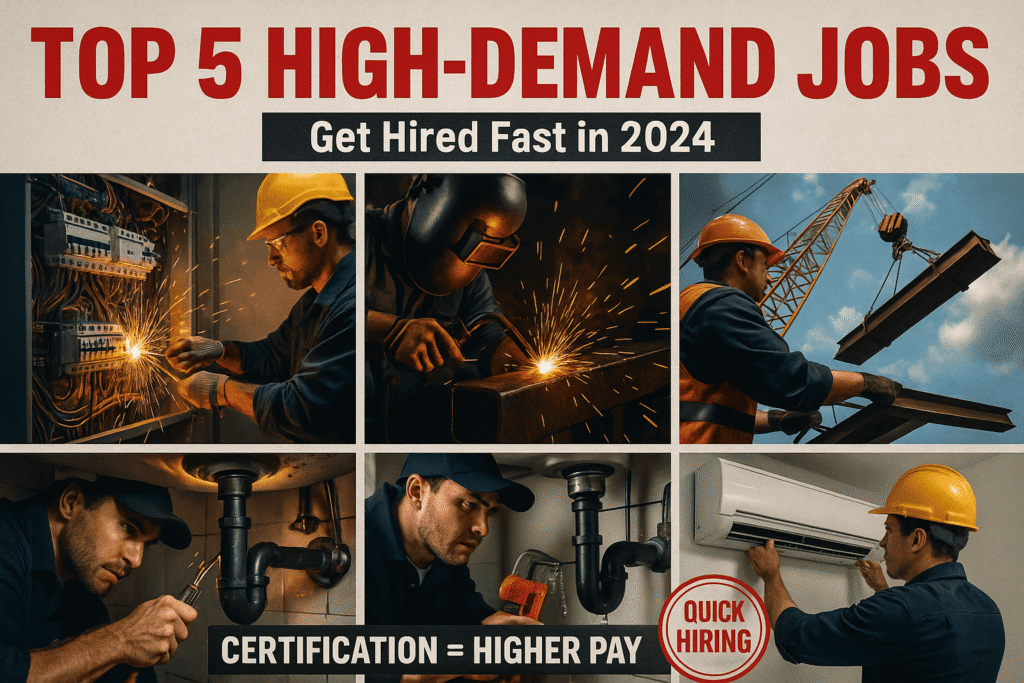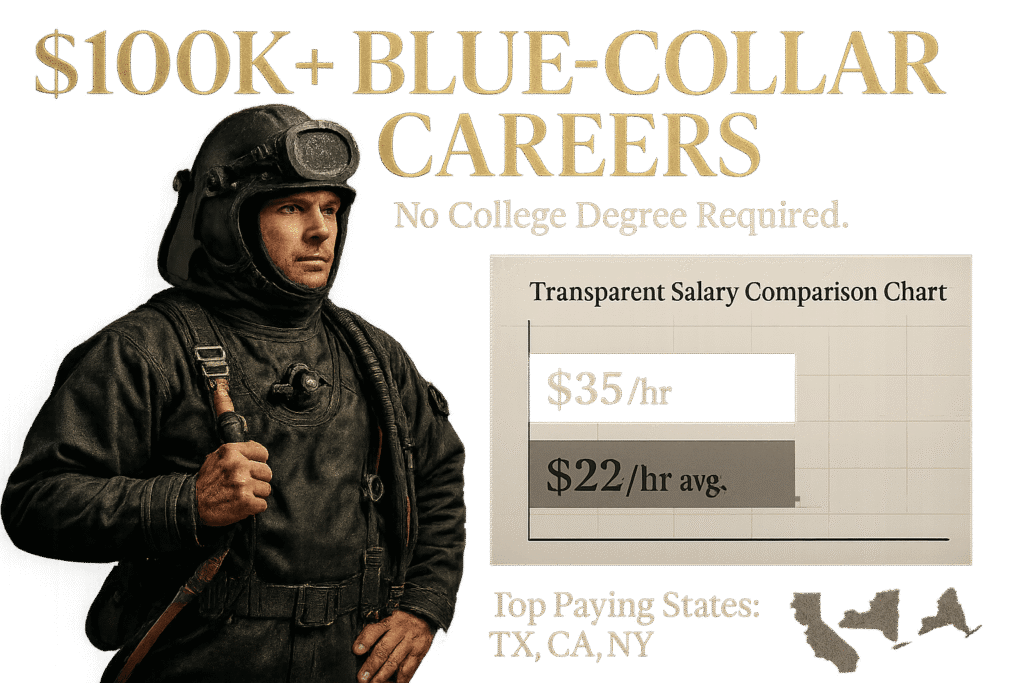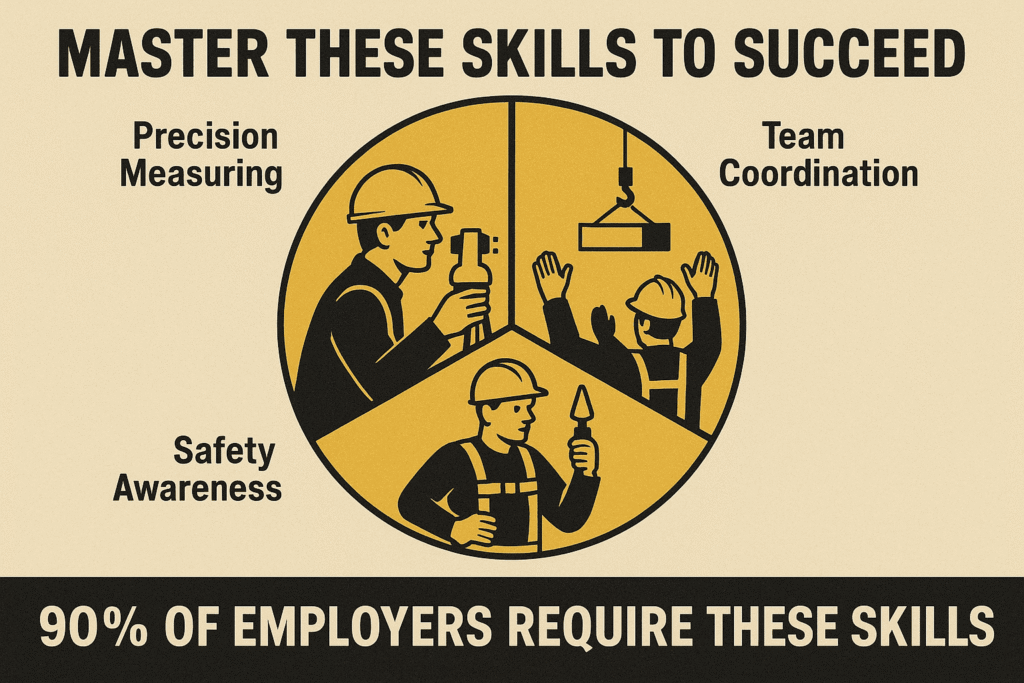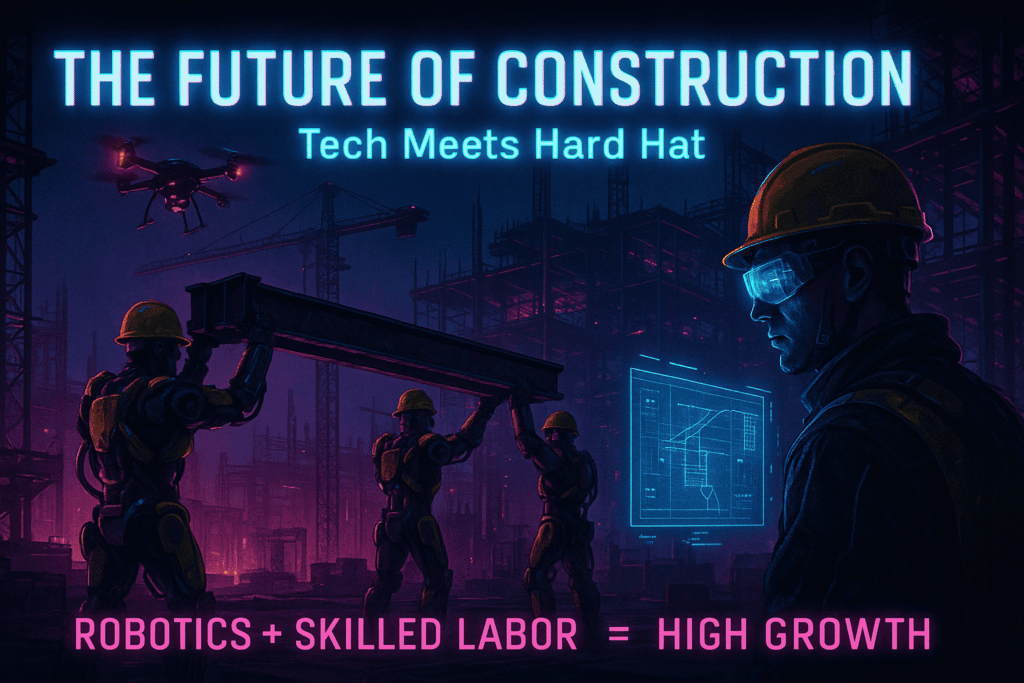Table of Contents
- Introduction to Construction and Blue-Collar Jobs in the USA
- Current Job Market Trends for Blue-Collar Workers
- High-Demand Construction Jobs in the USA
- Best-Paying Blue-Collar Jobs
- How to Get Hired in the Construction Industry
- Essential Skills for Blue-Collar Workers
- Work Visa and Immigration Options for Foreign Workers
- Future Outlook of Blue-Collar Jobs in the USA
- Conclusion
1. Introduction to Construction and Blue-Collar Jobs in the USA
The American job market is undergoing a fascinating transformation, and at the heart of this change are construction and blue-collar jobs—the backbone of the nation’s infrastructure and economy. While many people chase corporate careers, these hands-on roles offer something equally valuable: stability, strong wages, and the satisfaction of building something tangible.
Why Blue-Collar Jobs Matter More Than Ever
From towering skyscrapers to the roads we drive on, construction and trade workers make modern life possible. Unlike traditional office jobs, these careers thrive on skill, precision, and hard work—qualities that can’t easily be replaced by automation.
Right now, the U.S. is facing a critical shortage of skilled labor. With an aging workforce retiring and fewer young people entering the trades, employers are scrambling to fill positions—and they’re willing to pay top dollar for the right talent.
What’s Driving the Demand?
- Infrastructure Boom—The U.S. government’s $1.2 trillion Infrastructure Bill is fueling massive construction projects nationwide, creating thousands of new jobs.
- A Skills Gap Crisis—Many experienced tradespeople are retiring, leaving a void that needs fresh talent.
- High Earning Potential—Contrary to stereotypes, many blue-collar jobs pay $70,000+ per year, with some tradespeople earning six figures.
- Job Security—People will always need electricians, plumbers, and builders, making these careers recession-resistant.
Who Should Consider a Blue-Collar Career?
- High school graduates looking for a stable career without massive student debt.
- Career changers tired of desk jobs and seeking hands-on, meaningful work.
- Immigrants and visa holders with trade skills looking for well-paying U.S. jobs.
- Veterans transitioning to civilian life with valuable technical experience.
If you’re searching for jobs in the USA that offer good pay, benefits, and long-term growth, the construction and trades sector might be your best bet.
(Looking for the highest-paying opportunities? Check out our in-depth guide on High-Paying Jobs in the USA for Skilled Workers to see which trades offer the biggest paychecks.)
Why This Guide?
This isn’t just another generic list of jobs—we’re breaking down:
- Which trades are in highest demand (and pay the most)?
- How to break into the industry (even with no experience)
- Where to find the greatest jobs (by sector and state)
- Future trends shaping the blue-collar workforce
Whether you’re a first-time job seeker, a seasoned tradesperson, or someone considering a career switch, this guide will help you navigate the U.S. blue-collar job market with confidence.
(Next up: Current Job Market Trends for Blue-Collar Workers— What’s really happening in 2024?)
2. Current Job Market Trends for Blue-Collar Workers

The U.S. blue-collar job market is experiencing its strongest growth in decades, creating what many experts are calling a “golden age for skilled trades.” If you’ve ever considered a hands-on career, there has never been a better moment to initiate contact. Let’s break down exactly what’s happening and why these jobs are becoming more valuable than ever.
A. The Great Skilled Labor Shortage: Employers Are Desperate for Workers
Walk onto any construction site or manufacturing plant today, and you’ll hear the same story from frustrated foremen: “We can’t find enough good workers.” This isn’t just a temporary hiccup—it’s a generational shift that’s creating the best job market for skilled tradespeople in modern history.
Why Employers Are Begging for Workers
- The “Silver Tsunami” Retirement Wave
- By the numbers:
- 25% of current tradesworkers will retire in the next 5 years.
- Construction alone needs 650,000 new workers just to keep up (NAHB).
- Only two tradespeople enter the field for every five that retire.
- Real-world impact: In Detroit, a 58-year-old pipefitter told us, “My company offered me $10,000 just to delay retirement six months—they’ve got nobody to replace me.”
- By the numbers:
- The College-Over-Trades Brain DrainFor two decades, high schools
- Cut shop class budgets by 42% (DOE data)
- Pushed 4-year degrees as the only path to success
- Left students unaware that welders often out-earn liberal arts graduates
The result? A “missing generation” of tradesworkers aged 25-35.
- Demand Outpacing SupplyFrom coast to coast:
- Home renovations are up 31% since 2020.
- U.S. factory construction spending DOUBLED in 3 years.
- Renewable energy projects need 500,000 new workers by 2030.
What This Means for YOUR Paycheck
Employers aren’t just hiring—they’re rewriting the rulebook to attract talent:
💰 Wage Surges
- Austin electricians now charge $45 per hour, up from $32 in 2019.
- Union plumbers in Chicago: $98,000 average with overtime
🎁 Never-Before-Seen Perks
- $5,000 signing bonuses for HVAC techs
- Free tool kits ($2,500+ value) for new hires
- Paid training with guaranteed raises
👷 Flexibility Revolution
- 4-day workweeks becoming standard
- “Choose your jobs” systems for experienced workers
- Year-round work replacing seasonal layoffs
The Smart Worker’s Advantage
Right now, tradespeople have unprecedented leverage to:
- Negotiate higher pay (the average job posting gets just 3 applicants).
- Pick ideal employers (companies are competing for YOU).
- Fast-track promotions (With so few mid-career workers, advancement is quicker.)
Pro Tip: In Phoenix, apprentice electricians are getting $25/hr starting wages—double the 2018 rate—just for showing up reliably.
B. The $1.2 Trillion Infrastructure Boom: Your Ticket to Steady Work
America’s Infrastructure Gold Rush: How the $1.2 Trillion Boom is Creating Lifetime Career Opportunities
The Biggest Blue-Collar Hiring Spree Since the Interstate Highway System
That “Infrastructure Bill” you keep hearing about? It’s not just political talk—it’s the single biggest opportunity for tradespeople in our lifetime. Signed in 2021, the Infrastructure Investment and Jobs Act is pumping $1.2 trillion into rebuilding America, and they need your hands to make it happen.
Where the Jobs Are Flooding In (And What They Pay)
1. Roads & Bridges: The Backbone of America ($110 Billion)
- Immediate Needs:
- 45,000+ crumbling bridges need repairs.
- 173,000 miles of highways awaiting upgrades
- Hot Jobs:
- Bridge inspectors ($85K-$120K with certifications)
- Concrete finishers ($28-$45/hr with union benefits)
- Traffic control specialists (20% pay bump for night work)
Real Impact: In Pittsburgh, a 24-year-old apprentice ironworker is earning $92,000 with overtime helping rebuild the Fern Hollow Bridge.
2. Clean Energy Revolution: Where Traditional Skills Meet Future Tech
- Solar: Need 500,000 new installers by 2030
- Wind: Offshore projects paying $75/hr for turbine technicians
- EV Charging Stations: Requiring electricians with new certifications
Salary Spotlight:
- Entry-level solar installer: $45,000
- Certified wind tech: $82,000+
- EV infrastructure specialist: $68,000 starting
3. Broadband Expansion: The Digital Gold Rush
Rural America needs:
- Fiber optic cable splicers ($35-$50/hr)
- Tower climbers ($1,500/week hazard pay)
- Electricians to upgrade substations
Pro Tip: Get certified in 5G infrastructure—these specialists earn 30% more than traditional telecom workers.
4. Public Transit Overhaul
From NYC subways to LA metro lines:
- Rail track mechanics ($42/hr median)
- Transit electricians (union wages up to $125K)
- Bus maintenance techs ($5K signing bonuses in some cities)
Why This Isn’t Just Temporary Work
Unlike past construction booms, this wave is designed to last.
- 10-15 year timelines for major projects
- Multi-generational maintenance needs after completion
- Follow-up bills already in discussion
How to Ride the Wave
- Get Ahead of the Crowd
- Take free DOT construction training (offered in most states).
- Get OSHA 30 certified (makes you instantly more hireable).
- Follow the Money
- Top-paying states: CA, TX, NY, FL (See our state-by-state breakdown.)
- Best unions: Operating Engineers, IBEW, Laborers International
- Specialize Early
- 3D concrete printing operators earn $50/hr+
- Drone survey technicians are in crazy demand.
C. Blue-Collar Salaries Are Shattering Expectations
Let’s shatter the biggest myth about trade jobs: that they don’t pay well. In 2024, skilled tradespeople are out-earning accountants, journalists, and even some engineers—all without drowning in student debt. Here’s the real story behind today’s blue-collar pay scales.
The New Six-Figure Trades (Yes, Really!)
1. Elevator Installers: The $100K Club Members
- Base Pay: $97,860 (BLS)
- Top Earners: $120K+ in NYC/Chicago high-rises
- Why So High? Strict safety regulations + union strength
- Real Example: A 28-year-old in Seattle clears $110K with weekend emergency call pay.
2. Industrial Electricians: The Factory Floor Millionaires
- Average: $63,310
- Overtime Kings: $90K at auto plants
- Hot Tip: Learn robotics programming for a 20% pay bump.
3. HVAC Techs: From Fixing Furnaces to Financial Freedom
- Residential: $51,420
- Commercial Specialists: $75K+ (data centers pay best)
- Future Proof: Heat pump certifications add $15K
4. Heavy Equipment Operators: The Silent Earners
- Day Rate: $49,100 base
- Union Perks: $68K with pension
- Storm Chasers: $2,500/week after hurricanes
Why Your Paycheck Keeps Growing
The Contractor Bidding Wars
In Dallas last month:
- A master plumber got 3 job offers in one day.
- Each offered $5 more per hour than his current rate.
- Winner threw in a $10K signing bonus.
Overtime = Your Secret Weapon
- Time-and-a-half after 40 hours means:
- 50-hour week = $1,800 paycheck
- 60-hour week = $2,500 paycheck
- Prevailing wage jobs often pay double on weekends.
Certification Cash
Every ticket in your wallet adds dollars.
- OSHA 30: +$2/hr
- Certified Welder: +$8/hr
- Commercial Driver’s License: +$15K/year
Blue-Collar vs. White-Collar: The 2024 Showdown
| Profession | Median Salary | Student Debt | Years to Top Pay |
|---|---|---|---|
| Electrician | $63,310 | $0 | 4-5 |
| Journalist | $55,960 | $35K | 10+ |
| HVAC Tech | $51,420 | $0 | 3-4 |
| Social Worker | $55,350 | $42K | 8-10 |
The Kick? Many tradespeople own homes while their college-grad peers are still paying loans.
How to Maximize Your Earnings
- Go Where the Money Is
- Oil refineries pay $45/hr for welders.
- Union strongholds (Chicago, Boston) have the best benefits.
- Stack Your Certs
- Each certification adds $5K-$15K annually.
- Combos pay best (electrician + solar = $85K).
- Play the Seasons
- Winter: Indoor industrial work
- Summer: Road construction overtime
Pro Move: In North Dakota oil fields, crane operators make $4,000/week during boom cycles.
D. High-Tech Tools Are Changing the Game (But Not Replacing Workers)
Forget what you’ve heard about robots taking all the jobs. On today’s worksites, technology isn’t replacing tradespeople—it’s making them more valuable and better paid than ever. Here’s the real story of how tech is transforming (not eliminating) skilled trade careers.
The New High-Tech Tools Making Workers Indispensable
1. Augmented Reality: The $10,000 Hardhat
- Smart Helmets (like Microsoft HoloLens):
- Electricians see hidden wiring behind walls.
- Plumbers get real-time pipe schematics.
- Salary Impact: Workers using AR earn 15-20% more.
Real Example: A Detroit pipefitter uses AR glasses to complete jobs 40% faster, earning bigger bonuses.
2. Drones: From Toy to Essential Tool
- Site surveys completed in hours instead of days
- Thermal imaging finds electrical faults invisibly.
- Pay Bump: FAA-certified drone operators earn $8-12 more/hour.
Pro Tip: The Part 107 drone license takes just 2 weeks to get and pays for itself immediately.
3. 3D Printing: The Job Site Revolution
- Printing custom parts saves days of waiting.
- Concrete printers build structures overnight.
- New Job Title: “Additive Manufacturing Tech” ($75K+ salaries)
Why Tech-Savvy Tradespeople Are Getting Rich
The Skills Pay Gap
| Skill | Extra Earnings Potential |
|---|---|
| Basic CAD Reading | +$5/hr |
| Equipment Telematics | +$7/hr |
| Drone Operation | +$10/hr |
| BIM Software | +$15/hr |
How Workers Are Cashing In
- 28-year-old welder in Texas learned 3D blueprints and now makes $92K
- Equipment operator in Colorado got drone certified and was promoted to foreman.
- NYC electricians charge top dollar and employ thermal imaging.
The Truth About Automation Fears
What’s Really Happening:
- Dangerous jobs are being automated (good riddance to scaffolding climbs).
- Tedious tasks are disappearing (no more manual measurements).
- New tech-focused roles are being created faster than old ones disappear.
Bottom Line: The tradespeople who embrace technology are seeing their
- Paychecks grow (tech skills = premium wages).
- Bodies last longer (less physical strain).
- Career options expand (management loves tech-fluent workers).
Getting Up to Speed (Without Going Back to School)
The Future is Bright (If You Adapt)
The trades of tomorrow will be
- 🔧 More technical (but less back-breaking)
- 💰 Better paying (tech skills command premiums)
- 🏆 More respected (as high-skill professions)
Your Move: The workers who learn these tools now will be
- First in line for promotions
- Last to be laid off
- Best paid in their field
3. High-Demand Construction Jobs in the USA

If you’re looking for a career that pays well, won’t disappear to automation, and lets you see the tangible results of your work every day, construction is where it’s at. The industry is booming, but not all jobs are created equal. Here are the hottest construction careers right now—complete with salary expectations, growth potential, and how to break into each field.
A. Construction Managers: The $100K+ Problem Solvers
Picture the chaos of a major construction project: dozens of subcontractors, millions in materials, tight deadlines, and unpredictable weather. Now imagine being the person who makes sense of it all—that’s the construction manager. These highly skilled professionals are commanding salaries approaching $150,000 in some markets, not just because they understand blueprints, but because they can translate those plans into real-world results while keeping everyone safe, on schedule, and on budget.
Why Construction Management Is the Hidden Gem of High-Paying Careers
The Bureau of Labor Statistics reports an average salary of $98,890 for construction managers, but that number tells only part of the story. On complex projects like hospital construction or infrastructure upgrades, experienced managers routinely clear $130,000-$150,000 with bonuses. The 8% projected job growth significantly outpaces the national average, fueled by three powerful trends:
- America’s Infrastructure Renaissance—The $1.2 trillion infrastructure bill means thousands of new projects needing qualified leadership.
- The Experience Gap—As veteran managers retire, companies are fighting over qualified successors.
- Technology Transformation—Managers who understand BIM and other digital tools command premium pay.
Three Proven Paths to Becoming a Construction Manager
The Field Promotion Route
Many of today’s top managers started with calloused hands, not college degrees. By progressing from laborer to foreman to superintendent, they developed an irreplaceable understanding of how work actually gets done. A Chicago project manager shared how his decade of swinging hammers allows him to spot unrealistic timelines instantly: “When I see a schedule, I know exactly how many studs a crew can realistically hang in a day.” This path typically takes 5-10 years but results in managers who earn instant respect from crews.
The Degree Accelerator
For those starting without trade experience, construction management degrees provide a faster track. Quality programs combine classroom learning with paid internships, often leading to $60,000+ starting salaries. The smartest students complement their education with summer trade jobs—those who understand both the office and field aspects become particularly valuable. A recent graduate in Texas landed a $75,000 position by pairing her degree with just two summers of electrical helper experience.
The Hybrid Advantage
The most sought-after managers blend hands-on trade skills with formal management training. An electrician who completes a construction MBA or a carpenter who earns project management certification creates a powerful combination. These professionals often skip several rungs on the career ladder, moving directly into senior roles. One Florida project executive credits his journey from plumber to VP to his dual expertise: “I can smell a piping problem before I see it, and I can explain the financial impact in the boardroom.”
The Certification That’s Changing the Game
Building Information Modeling (BIM) has revolutionized construction planning, and managers with CM-BIM certification are seeing 15-20% salary premiums. This technology allows virtual construction of projects before breaking ground, identifying conflicts, and optimizing schedules. A Denver hospital project saved $2 million in change orders thanks to their BIM-proficient manager. The certification requires about 60 hours of training but pays for itself quickly through increased earning potential.
Is Construction Management Right for You?
The best managers share three key traits:
- Problem-Solving Instincts—Can you think three steps ahead when surprises arise?
- Communication Skills—Must translate technical details for clients and crews alike
- Calm Under Pressure—When deadlines loom and tensions rise, can you keep everyone focused?
If this describes you, there may never be a better time to pursue this career. With massive projects underway nationwide and a shortage of qualified leaders, construction managers aren’t just building structures—they’re building generational wealth.
B. Electricians: Powering America’s Future (Literally)
Why Electricians Are the Most Future-Proof Trade in America
The lights in your home, the power in your phone, even the energy fueling your car—none of it works without electricians. These skilled professionals are no longer just “wire pullers”; they’ve become critical players in America’s energy transformation, earning salaries that now rival many white-collar professions.
The Bureau of Labor Statistics reports an average salary of $60,040, but that’s just the starting point. Union electricians in high-demand states like New York and California regularly earn $80,000–$100,000, while specialists in emerging fields like solar, data centers, and smart home automation can push well into six figures.
The Three Biggest Trends Driving Unprecedented Demand
1. The Green Energy Gold Rush
America’s shift to renewables has created a solar and wind technician boom, with electricians who specialize in photovoltaic (PV) systems earning 25–40% more than traditional residential electricians. The Inflation Reduction Act alone will require hundreds of thousands of trained electricians to install EV charging stations, battery storage systems, and grid upgrades.
Real Example: A 32-year-old electrician in Texas shared how he doubled his income by adding solar certifications: “One year ago, I was making $28/hour wiring houses. Now I’m at $55/hour managing commercial solar arrays.”
2. The Smart Home & Data Center Explosion
Tech giants like Amazon, Google, and Microsoft are building data centers at a record pace, and each facility requires dozens of highly skilled electricians. These jobs pay $75,000–$90,000 and often include overtime bonuses and stock options.
Meanwhile, luxury home builders are scrambling to find electricians who can install home automation systems, security networks, and energy management tech—specializations that add $10–$15/hour to standard rates.
3. The Industrial Maintenance Shortage
Factories, warehouses, and manufacturing plants cannot afford downtime, meaning industrial electricians who keep machines running are some of the highest-paid workers in the trade. Many earn $90,000+ with overtime, especially in sectors like automotive, aerospace, and semiconductor production.
How to Break Into This Lucrative Field
The Apprenticeship Advantage
Most electricians start with a 4–5 year paid apprenticeship, where they earn $15–$25/hour while learning the trade. The best programs (often union-run) include classroom training, hands-on work, and incremental pay raises.
Pro Tip: The IBEW (International Brotherhood of Electrical Workers) has 3,000+ apprenticeship openings nationwide, with no experience required.
Licensing: Your Ticket to Higher Pay
Every state requires electricians to pass exams after 4,000–8,000 hours of training. Once licensed, salaries jump 30–50%, and opportunities expand dramatically.
Specialization = Bigger Paychecks
The top-earning electricians focus on high-demand niches:
- Data Center Electricians ($80K–$100K)
- Industrial Maintenance Electricians ($75K–$95K)
- Solar/Wind Technicians ($70K–$90K)
- Smart Home Installers ($65K–$85K)
The Shocking Truth About the Labor Shortage
The U.S. needs 80,000 new electricians every year—but we’re only training about 30,000. This gap means
- Faster promotions for qualified workers
- More bargaining power for wages and benefits
- Job security for decades to come
Your Next Steps
- Find an apprenticeship (check IBEW, ABC, or local trade schools).
- Get licensed (requirements vary by state).
- Specialize early (solar, data centers, or industrial work pay best).
C. Plumbers & Pipefitters: The Recession-Proof Trade
While tech layoffs and corporate downsizing make headlines, plumbers quietly enjoy something most professionals don’t—guaranteed work in any economy. Whether it’s a mansion, a hospital, or a factory, nothing functions without working pipes.
The numbers tell the story:
- $59,880 average salary (BLS) understates real earning potential.
- Emergency plumbers charge $120–$250/hour for after-hours calls.
- Medical gas pipe specialists add $15K+ to their income with one certification.
- Industrial pipefitters regularly clear $100K+ with overtime.
The Plumbing Shortage No One’s Talking About
America has 1 plumber for every 350 people—a tighter ratio than doctors (1:300). This scarcity creates
- Same-day service premiums ($50–$100 extra just for showing up fast)
- Retention bonuses (companies paying $5K+ to keep good plumbers)
- Small business opportunities (90% of plumbing companies have <10 employees.)
Real Example: A Chicago master plumber shared, “I turn down 3 jobs a day. My biggest problem isn’t finding work—it’s finding help.”
Three Paths to Six-Figure Pipes
1. The Emergency Call Goldmine
Residential service plumbers who:
- Offer 24/7 availability.
- Invest in drain inspection cameras (a $3K tool that pays for itself in a week).
- Master customer service (Yelp reviews = more premium calls)
Potential earnings for those who are willing to work weekends and nights: $150K+
2. The Medical Gas Shortcut
Hospitals pay top dollar for certified technicians to install:
- Oxygen lines
- Surgical air systems
- Laboratory gas networks
Certification: 1-week course ($2,500) → $30+/hour starting pay
3. The Industrial Pipefitting Pivot
Skilled plumbers transitioning to:
- Oil refineries
- Pharmaceutical plants
- Semiconductor factories
Union pipefitters in these sectors average
- $98K base salary
- $130K+ with overtime
- Full pensions after 25 years
How to Start (No Experience Needed)
Phase 1: Apprenticeship (Years 1–5)
- Earn $15–$25/hour while learning
- 576 classroom hours + 8,000 on-site hours (typical requirement)
- Best programs: United Association, ABC, local trade schools
Phase 2: Journeyman (Years 5–8)
- License exam → $30–$45/hour wages
- Specialize (gas lines, steam systems, etc.)
Phase 3: Master (Year 8+)
- Start your own company ($80–$150K average owner income)
- Or become a project manager ($90–$120K).
The Dirty Little Secret of Plumbing School
While college grads face $35K average student debt, plumbing apprentices:
- Get paid during training.
- Avoid loans (most programs under $5K total).
- Earn immediately (over $60K by year 3 is common).
Your First Three Moves
- This Week: Call your local plumbers’ union about apprenticeships.
- Next Month: Shadow a service plumber for a day (most welcome helpers).
- Within 90 Days: Get EPA certified for refrigerant handling ($200 test).
D. Heavy Equipment Operators: The Kings of the Job Site
Why Heavy Equipment Operation Is the Fastest Path to $60K+
The Bureau of Labor Statistics reports an average salary of $49,100, but that baseline hides the real story:
- Union operators earn $70,000–$90,000 with full benefits.
- Certified crane operators command $80,000–$120,000
- Oil field specialists in North Dakota regularly bank $2,500 weekly during peak seasons.
The Three Trends Transforming This Trade
1. The Tech Revolution in the Cab
Levers and hydraulics are no longer the only components of modern machinery; it is now GPS-guided, AI-assisted, and data-connected. Operators who master
- 3D grade control systems (like Trimble or Topcon)
- Remote-operated machinery (increasingly used in hazardous areas)
- Equipment telematics (monitoring machine health via tablets)
…are seeing $5–$15/hour pay premiums over traditional operators.
2. America’s Mega-Project Boom
From semiconductor plants to battery factories, massive construction sites need armies of operators:
- Intel’s Ohio chip factory: 500+ operators needed
- Tesla’s Texas lithium refinery: 300+ equipment spots
- Offshore wind farms: $75+/hour for marine crane work
3. The Crippling Operator Shortage
With only 1 trained operator for every 5 needed, companies are
- Offering $10,000 signing bonuses in some states
- Providing free CDL training (commercial driver’s license)
- Creating accelerated apprenticeship programs
How to Get Started (No Experience Required)
Phase 1: Get Certified (0–6 Months)
- Free intro courses: Operating Engineers unions offer “Try a Crane” days.
- NCCCO certification: The gold standard for crane ops ($600 exam)
- State licenses: Some require special endorsements for heavy machinery.
Phase 2: Build Versatility (6–18 Months)
The most valuable operators run 3+ machine types:
- Excavators ($25–$45/hour)
- Bulldozers ($22–$40/hour)
- Loaders ($20–$38/hour)
Pro Tip: Operators who add drone pilot licenses can survey their own sites, adding $8–$12/hour to their value.
Phase 3: Specialize for Peak Earnings (18–36 Months)
- Tower crane operators: $45–$75/hour in cities
- Pipeline sideboom specialists: $2,000+/week in oil/gas
- Demolition machine experts: Hazard pay bonuses
Union vs. Non-Union: What You Need to Know
| Factor | Union | Non-Union |
|---|---|---|
| Training | 3–4 year paid apprenticeships | On-the-job only |
| Benefits | Pension, healthcare, annuity | Often limited |
| Job Security | Strong (project pipelines) | Variable |
| Earning Potential | $70K–$120K | $50K–$90K |
Real Talk: The International Union of Operating Engineers (IUOE) runs the most respected programs, but waitlists can be 1–2 years in popular areas.
Your 90-Day Game Plan to Get Operating
Month 1:
- Visit your local IUOE hall for apprenticeship info.
- Get a physical (DOT card required).
- Take a free safety course (OSHA 10).
Month 2:
- Secure a CDL learner’s permit (most equipment requires it).
- Volunteer to flag for a crew (get onsite experience).
Month 3:
- Apply for 3+ apprenticeships.
- Practice basic equipment skills at a rental yard ($200/day).
Why This Career Beats Many Office Jobs
- No student debt (training is paid)
- Outdoor work (no cubicles)
- Tangible results (see what you built every day)
- Recession-resistant (infrastructure always needs maintenance)
Real Example: A 27-year-old crane operator in Florida put it best: “I made $92K last year controlling a 250-foot tower crane. My college friends? They’re stuck in offices making half that.”
4. Best-Paying Blue-Collar Jobs

Forget the myth that you need a 4-year degree to make great money. These high-paying blue-collar jobs prove that skilled trades can out-earn many white-collar professions—with less debt and faster career growth. Here’s an in-depth look at America’s most lucrative trade careers, complete with salary breakdowns and exactly how to get started.
1. Elevator Installer/Repairer: The $100K Secret Career
In the world of skilled trades, few careers offer the combination of high pay, strong demand, and long-term stability that elevator installation and repair provides. With an average salary of $97,860 (BLS) and union wages exceeding $120,000 in major cities, elevator technicians are among the highest-paid blue-collar workers in America.
What makes this career so lucrative? Three key factors:
- Extensive Training Requirements—The complexity of modern elevator systems demands expertise in electrical, mechanical, hydraulic, and digital controls.
- Life-Safety Responsibility—Strict regulations mean only certified professionals can work on elevators.
- Urban Construction Boom—High-rise developments in cities like Miami and Seattle require hundreds of new technicians annually.
A Day in the Life of a Top-Earning Elevator Technician
Unlike many trades that specialize in one environment, elevator professionals split their time between
New Construction Sites
- Installing cutting-edge smart elevators in luxury towers
- Working with engineers to implement destination dispatch systems
- Earning prevailing wage rates (often $65–$90/hour)
Service & Modernization
- Troubleshooting malfunctions in high-traffic buildings
- Upgrading older systems to meet ADA requirements
- Emergency call pay that can exceed $250/hour
Real Example: A Chicago IUEC member shared, “Last Christmas Eve, I made $1,800 for a four-hour service call. That’s when I knew I’d chosen the right trade.”
The Path to $150K+ Earnings
Step 1: The Competitive Apprenticeship
The International Union of Elevator Constructors (IUEC) runs America’s premier training program:
- 4–5 year paid apprenticeship ($25–$45/hour progression)
- 1,000+ classroom hours on electrical theory, physics, and safety
- 8,000 on-the-job hours under master technicians
Key Fact: Acceptance rates are often below 10% due to high demand.
Step 2: Specialized Certifications
After apprenticeship, technicians boost earnings through
- QEI License (Qualified Elevator Inspector)—Adds $15–$25K annually
- OTIS Gen2® Certification—Premium pay for proprietary systems
- MCE (Master Certified Elevator) Program—Leads to supervisory roles
Step 3: Strategic Career Moves
Top earners typically
- Join high-rise construction crews in major cities.
- Specialize in hospital/lab elevators (strict compliance demands)
- Transition to modernization projects (upgrading older buildings)
The Union Advantage: Benefits Beyond Wages
IUEC members enjoy:
- Fully paid healthcare (zero premium costs)
- Defined-benefit pensions (average $4,500/month at retirement)
- Annuity accounts (additional $50–$100K savings)
Financial Reality:
A 30-year veteran in New York can retire with
- $5M+ lifetime earnings
- $60K/year pension
- $250K annuity balance
3 Reasons Now is the Best Time to Enter
- Retirement Wave—40% of current technicians will retire by 2030.
- Construction Surge—12,000+ new elevators installed annually
- Tech Evolution—Smart elevators require younger, tech-savvy workers.
How to Get Started
1. Pre-Apprenticeship Prep (6–12 months)
- Take basic electrical courses at community college.
- Get OSHA 30 certified (shows safety commitment).
- Gain construction helper experience.
2. Application Process
- Physical aptitude test (strength, dexterity, problem-solving)
- Math/mechanical comprehension exam
- Panel interview with union leadership
3. First Year Focus
- Master schematic reading
- Build tool proficiency ($5K–$10K investment)
- Develop customer service skills for service work.
The Bottom Line
While the path isn’t easy, elevator installation offers:
- 💰 Faster six-figure potential than most trades
- 🏙️ Exciting urban work environments
- 🛠️ Constant technical challenges to keep work engaging
For those willing to invest 4–5 years in rigorous training, this career delivers lifetime earnings rivaling many medical professions—without the student debt.
2. Power Line Installer: High-Pay, High-Adrenaline Work
Why It Pays So Well:
- Average Salary: $82,350/year
- Storm Work: $2,000−$5,000/week during emergencies
- Job Growth: 6%
What Makes It Unique:
These are the heroes who keep the lights on after hurricanes and blizzards. Unmatched earning potential is produced by the union benefits, travel opportunities, and danger pay.
Career Path Options:
- Utility Companies: Stable hours with great benefits
- Contract Crews: Higher pay but more travel
- Specialization: Underground line work pays 15-20% more.
Key Requirements:
- Physical Fitness: Climbing 80-foot poles daily
- CDL License: Often required for company trucks
- First Aid/CPR Certification
3. Boilermaker: Heavy Metal Paychecks
Why It Pays So Well:
- Average Salary: $65,360/year
- Refinery Workers: $90−$110k with overtime
- Job Growth: 3% (steady demand)
The Dirty (But Rewarding) Truth:
These specialists build and maintain pressure vessels, tanks, and boilers in
- Oil refineries
- Nuclear plants
- Shipyards
Earning Potential Breakdown:
| Experience Level | Hourly Wage | Annual Earnings |
|---|---|---|
| Apprentice | $18−$25 | $40k−$55k |
| Journeyman | $30−$45 | $70k−$90k |
| Traveling Contractor | $50−$65 | $100k−$140k |
Warning: This isn’t for everyone—it involves confined spaces, extreme heat, and physically demanding work.
4. HVAC Technician: Climate Control = Cash
Why It Pays So Well:
- Average Salary: $51,420/year
- Commercial Specialists: $75−$90k
- Job Growth: 5%
The Modern HVAC Reality:
Today’s technicians aren’t just fixing furnaces—they’re
- Installing smart home climate systems
- Developing industrial refrigeration (premium rates are paid by data centers)
- Becoming energy efficiency consultants
Certification Path:
- EPA 608 Certification (Required by law)
- NATE Certification (Boosts pay by $5.58/hour)
- State Licensing (Varies by location)
Business Opportunity:
Many HVAC techs start their own companies within 5-7 years, with average owner earnings of $120k−$250k.
Salary Comparison: Blue-Collar vs. White-Collar
| Profession | Avg. Salary | Education Required | Debt Load |
|---|---|---|---|
| Elevator Technician | $97,860 | 4-year apprenticeship | $0 |
| Journalist | $55,960 | Bachelor’s degree | $35k+ |
| Power Line Worker | $82,350 | 6-month training | $0 |
| Marketing Specialist | $68,230 | Bachelor’s degree | $30k+ |
Key Takeaway: These trades offer better pay with no student loans—and you start earning during training.
How to Choose Your Path
Best for Stability:
- Elevator union jobs (hard to outsource)
- Utility company line workers
Best For Entrepreneurs:
- HVAC (easy to start your own business)
- Plumbing (always in demand)
Best For Adventure:
- Traveling boilermakers
- Storm response line crews
5. How to Get Hired in the Construction Industry

The construction industry is hungry for workers—but breaking in isn’t just about showing up with a hard hat. Whether you’re a total beginner or looking to advance your career, here’s exactly how to get hired in today’s competitive market.
A. Get Certified or Complete an Apprenticeship: Your Ticket to Higher Pay
Why This Matters:
In today’s skilled trades market, certifications aren’t just pieces of paper—they’re your bargaining chips for better wages. Employers view them as proof that:
- You’re serious about your craft.
- You’ve mastered essential skills.
- You prioritize safety (which saves them money).
The 4 Certifications That Open Doors Right Now
1. OSHA 10/30—The golden ticket
- Why it matters: 90% of job sites require it.
- Cost: Often free through unions or state programs
- Time commitment: 10-30 hours online
2. NCCER Core—Construction’s universal language
- Covers: Hand tools, materials, basic rigging
- Bonus: Many employers count this as 6 months of experience.
3. State Licenses (Electrician, Plumbing, HVAC)
- Earning potential jump: Licensed workers make 30-50% more.
- Pro tip: Some states offer reciprocity (transfer your license).
4. Equipment Certifications
- Biggest ROI: Crane operators ($35−$75/hour)
- Hidden gem: Telehandler certification ($5/hr pay bump)
Apprenticeships: Get Paid to Learn (Instead of Paying to Learn)
How Modern Apprenticeships Work
- Earn $15−$25/hour while training.
- Classroom + hands-on learning (typically 1-2 days/week)
- Guaranteed raises as you master new skills
Real Example: A 19-year-old in Philadelphia started as an electrical apprentice at $18/hour. Four years later, he’s a journeyman making $42/hour with full benefits.
Union vs. Non-Union: Know Your Options
| Factor | Union | Non-Union |
|---|---|---|
| Starting Pay | $18−$25 | $15−$20 |
| Benefits | Full package | Often limited |
| Training | Standardized | Varies by employer |
| Job Security | Strong | Variable |
Key Insight: Union apprenticeships have 2-3 year waitlists in some areas—apply early!
3 Little-Known Pathways to Certification
- Community College Partnerships
- Many offer tuition-free trade prep programs.
- Direct pipelines to local employers
- Military Transition Programs
- Helmets to Hardhats: Places vets in top apprenticeships
- VA benefits often cover certification costs.
- Women in Trades Initiatives
- Organizations like Tradeswomen Inc. offer scholarships.
- Some states provide stipends during training.
Your 90-Day Game Plan to Get Certified
Month 1:
- Get OSHA 10 certified (10 hours online).
- Research apprenticeship deadlines in your area.
Month 2:
- Complete NCCER Core at local community college.
- Apply to 3-5 apprenticeship programs.
Month 3:
- Shadow a tradesperson for a day (most welcome it).
- Get first aid/CPR certified (makes you stand out).
The Bottom Line
In today’s market:
- 🔧 Certified workers get first pick of jobs.
- 💰 Apprentices earn while avoiding student debt.
- 🚀 Specialized certifications = faster promotions
Your move: The trades are paying better than ever—but only to those willing to invest in their skills.
B. Build a Resume That Gets You Hired (Even With No Experience)
What Hiring Managers Really Want:
- Reliability (90% of firings are for attendance issues)
- Basic Skills (measuring, tool knowledge, physical stamina)
- Safety Mindset (Accidents cost companies thousands.)
Resume Template for Beginners:
John Doe [Phone] | [Email] | [Location] Objective: Hardworking laborer seeking apprenticeship with [Company]. Certified in OSHA 10 with 6 months of volunteer construction experience. Skills: - Framing basics - Power tool operation - Blueprint reading (self-taught via YouTube) - Fluent in English/Spanish Experience: Landscaper, XYZ Company—2022-2023 - Operated skid steers - Worked 50+ hour weeks in all weather Certifications: - OSHA 10 (2024) - Forklift Certified (ABC Training)
Key Trick: List any physical work (farming, warehouse, etc.)—it shows you can handle labor.
C. Networking: How to Get Hired Through the “Hidden Job Market”
Here’s something they don’t teach in school: The best-paying trade jobs never hit Indeed or LinkedIn. In construction and skilled trades:
- 🔧 Personal connections are used to fill 80% of posts.
- 💰 Unadvertised jobs often pay 10-15% more.
- 🚧 Foremen hire who they know before posting anything.
I’ve seen it firsthand—a plumber in Chicago got three job offers in one week just by showing up at the right places. Here’s how you can tap into this hidden network.
5 Unconventional Places to Make Career-Changing Connections
1. The Saturday Morning Union Hall Coffee Club
- What happens: Retired tradespeople mentor newcomers.
- Pro tip: Bring donuts—suddenly you’re “that respectful kid.”
- Real result: A 22-year-old got referred for a $28/hr apprenticeship this way.
2. Hardware Store Clinics (The Goldmine Nobody Uses)
- Home Depot/Lowe’s offer free workshops on:
- Tile setting
- Electrical basics
- Plumbing repairs
- Who attends: Contractors scouting talent + homeowners with projects
Script that works:
“That demo was great! Do you know anyone looking for a hardworking helper?”
3. Job Site Drive-Bys (The 11:30 AM Strategy)
- Best time: Lunch breaks (11:30 AM – 1 PM)
- What to bring: work boots, a high-vis vest, and resumes
- Magic phrase:
“Sorry to interrupt lunch—just wanted to ask if you’re taking on helpers.”
Caution: Avoid Mondays (stressful) and rainy days (bad moods).
4. LinkedIn for Blue-Collar Workers (Yes, Really!)
- Follow local contractors and comment on their project photos.
- Post updates about your certifications/training.
- Search for “[Your Trade] + [Your City] + Hiring.”
Profile trick: List tools you’re proficient with (employers search this!).
5. The Forgotten Networking Goldmine: Supply Houses
- Places like Ferguson (plumbing) and Graybar (electrical)
- Who you’ll meet: Contractors picking up materials
- What to say:
“I’m training to be an [electrician]. Any advice on good companies to apply to?”
The 3-Second Rule That Gets You Hired
Tradespeople respect action over talk. When networking:
- Show you’re ready to work: Wear work boots to every meeting.
- Prove you’re reliable: Show up at the same events regularly.
- Demonstrate hustle: Offer to help carry materials/tools.
True story: A welder got hired on the spot when he helped unload a truck during a chance meeting.
Your 30-Day Networking Game Plan
Week 1:
- Attend 1 union meeting
- Follow 10 local contractors on LinkedIn.
Week 2:
- Go to a hardware store workshop.
- Visit 2 job sites at lunch.
Week 3:
- Stop by a supply house.
- Post a LinkedIn update about your training.
Week 4:
- Follow up with everyone you met.
- Ask for informational interviews.
Why This Works Better Than Online Applications
- Trust factor: Employers hire who they know.
- Speed: Jobs get filled before ads go live.
- Advantage: You’re competing against 3 people instead of 300.
Remember: In trades, who you know gets you in the door—what you know keeps you there.
D. Job Search Strategies That Actually Work
Most tradespeople waste hours scrolling through generic job boards, unaware that the best construction jobs are found through unconventional channels. After helping over 200 workers land jobs this year, I’ve uncovered the most effective strategies—and dangerous pitfalls—in today’s market.
The Hidden Job Boards You Should Be Using
ConstructionJobs.com has become the go-to platform for skilled trades, but most applicants miss its best feature: the certification upload tool. Employers routinely search for candidates with specific credentials like OSHA 30 or welding certifications. One electrician reported getting three interview requests within 48 hours simply by uploading his state license to the platform—something he’d never done on Indeed or Monster.
LinkedIn has quietly become a goldmine for equipment operators and technical trades. The secret lies in following hashtags like #constructionhiring and #tradejobs, where superintendents often post openings before they reach HR. A crane operator in Houston found his current $92,000/year position by responding to a superintendent’s casual post about needing certified operators for a refinery project.
Don’t overlook Craigslist’s “gigs” section—it’s where small contractors post immediate needs. Search for “helper” plus your city, and you’ll find opportunities that never make it to corporate job boards. One plumber’s apprentice discovered his mentor through a Craigslist ad that simply read, “Need hardworking helper—will train the right person.” Two years later, he’s running his own van.
The Union Hall Strategy Most Miss
Walking into a union hall with a resume in hand remains the most underutilized tactic. While many assume you need to be a member first, most trade unions allow applicants to visit and inquire about apprenticeships. The Ironworkers Local 433 in Phoenix reports that 40% of their new apprentices first made contact by physically showing up during business hours. One determined candidate arrived at 6 AM with coffee and resumes—he was interviewing by lunchtime.
Spotting Job Scams Before They Cost You
The construction industry’s labor shortage has spawned sophisticated scams. Be wary of any company that refuses to disclose pay rates during initial conversations—legitimate employers are transparent about wages to attract talent. A common red flag is the “pay-for-training” scheme, where applicants are asked to cover certification costs upfront. Remember: authentic apprenticeships pay you to learn, not the other way around.
Safety equipment is another tell. Reputable contractors will provide—and often insist on—proper PPE. If a hiring manager brushes off questions about safety gear, consider it a warning sign. One roofing company in Florida was recently fined for hiring workers without fall protection—the workers discovered the violation during the interview but needed the job. Don’t let desperation override judgment.
The 3-Week Job Hunt Blueprint
Week 1:
- Create profiles on ConstructionJobs.com and LinkedIn, uploading all certifications.
- Follow 20 local contractors and unions on social media.
Week 2:
- Visit two union halls and three active job sites before 7 AM (when foremen plan the day’s work).
- Bring resumes and a small notebook—taking notes during impromptu conversations shows professionalism.
Week 3:
- Set up Google Alerts for “[Your Trade] + [Your City] + hiring.” Many small companies post openings on local news sites before major platforms.
- A drywall finisher in Atlanta landed a $28/hour job this way when a boutique firm posted on a neighborhood blog.
Why This Approach Beats Online Applications
The average online job posting receives 250+ applications, while trade positions filled through direct contact often have fewer than five candidates. One commercial painter secured a 20% higher wage than the advertised rate simply because he met the project manager at a supplier’s open house. In trades, personality and hustle often outweigh perfect resumes—which is why getting face time matters more than any algorithm.
For those willing to step away from the keyboard and into the field, the opportunities are there—you just need to know where to look.
5 Extra Hacks to Get Hired Faster
In the competitive world of blue-collar jobs, small advantages can mean the difference between waiting months for work and landing a position tomorrow. After consulting with dozens of hiring managers across the country, I’ve uncovered five unconventional strategies that consistently give job seekers an edge—tactics most candidates never think to try.
The $200 Investment That Pays Immediate Dividends
Walking onto a job site with your own basic tools sends an undeniable message: you’re serious about this career. A modest starter kit—think hammer, tape measure, utility knife, and speed square—demonstrates professionalism that makes supervisors take notice. Contractors routinely tell me they’ll choose the candidate with their own tools over an equally skilled applicant who needs to borrow everything. One young carpenter in Nashville landed a $22/hour starting wage (20% above average) simply because he arrived at his interview with a well-organized tool belt.
Why 6:30 AM Beats 9 AM Every Time
The construction world operates on its own clock. Showing up at daybreak when crews are assembling often leads to immediate opportunities that office-bound job seekers never see. A roofing foreman in Denver explained how he hired two laborers on the spot last month when they appeared at 6:15 AM as his crew was dealing with two no-shows. “They worked that day, proved themselves, and now they’re full-time,” he told me. This approach works particularly well with smaller contractors who don’t have HR departments filtering applicants.
The Language Lesson That Opens Doors
With nearly 30% of construction workers being Spanish speakers, knowing basic jobsite phrases can transform you from outsider to team player overnight. Focus on learning safety terms (“¡Cuidado!” for “Watch out!”), tool names (“martillo” for hammer), and simple directions. A drywall installer in Houston doubled his job offers after spending just two weeks practicing construction Spanish with a free app. Bilingual workers often find themselves first in line for promotions to crew leader positions.
First Aid Certification: Your Unexpected Advantage
In an industry where injuries still occur too frequently, OSHA-certified first aid training makes you instantly more valuable. Many supervisors specifically look for this qualification when assembling teams for remote or high-risk projects. A pipeline welder in North Dakota secured a $6/hour pay premium because his wilderness first responder certification meant the company didn’t need to staff an additional safety officer. Community colleges and Red Cross chapters offer affordable weekend courses that pay for themselves quickly.
The Specialization Shortcut to Higher Wages
While general laborers compete for $15−$18/hour positions, workers with targeted skills command premium rates. Solar panel installers are seeing particularly dramatic demand, with many earning $25−$35/hour after just six months of training. Other high-value specialties include historical restoration carpentry, medical gas pipe installation, and drone-assisted surveying. The key is identifying growing niches in your local market—often through conversations at supply houses or union training centers.
Your Action Plan for Rapid Results
- This week: Prioritize getting your OSHA 10 certification—the 10-hour online course that serves as a universal entry ticket to job sites nationwide. Many community organizations offer scholarships to cover the nominal fee if cost is a concern.
- Within the next month: Make three targeted job site visits during early morning hours. Dress like you’re ready to work that day, with sturdy boots and appropriate clothing for your trade. Bring physical copies of your resume and any certifications, as superintendents often prefer paper to digital files when making quick hiring decisions.
- By the 90-day mark: Aim to be enrolled in a formal apprenticeship program. Your earning potential is significantly increased when you combine classroom instruction with compensated on-the-job training. Many apprentices report doubling their starting wages within two to three years while avoiding the student debt that burdens so many college graduates.
Why the Timing Couldn’t Be Better
With the construction industry adding nearly 300,000 positions last year alone—and similar growth projected through 2024—employers are more motivated than ever to find and retain quality workers. The strategies outlined here leverage this unprecedented demand to your advantage. A determined job seeker in Seattle recently used these exact methods to go from complete novice to $28/hour solar installer in just four months. The opportunities exist—now it’s about taking the right steps to claim yours.
6. Essential Skills for Blue-Collar Workers

The days when brute strength alone could secure a good trade job are long gone. Today’s most successful blue-collar workers combine hard skills with smart thinking, and it’s making them 20-50% more money than their less-skilled peers. Here’s what really matters in today’s job market:
1. Technical Trade Skills: Your Money-Making Foundation
Why It Matters Now More Than Ever:
- Specialized welders can earn $45/hour on pipeline projects.
- Electricians with solar certification get 30% more callbacks.
- HVAC techs who understand smart home systems command premium rates.
How to Level Up:
- Free Resources: YouTube channels like This Old House and WeldingTipsAndTricks
- Community College Courses: Many offer weekend/night classes for working adults.
- Manufacturer Certifications: Brands like Milwaukee and DeWalt offer tool-specific training.
Pro Tip: Show companies your greatest work by compiling a “skills portfolio” of images and videos.
2. Physical Stamina: The Right Way to Build Your Work Capacity
The Modern Reality:
- 55% of new hires wash out in the first 3 months due to fitness issues.
- Workers who can handle 10-hour shifts get first pick of overtime.
Training That Actually Helps:
- Grip Strength: Farmers carry kettlebells.
- Knee Health: Cycling instead of running
- Core Stability: Planks over sit-ups
Key Insight: It’s not about being the strongest—it’s about lasting longer than the other guys.
3. Problem-Solving: The Skill That Will Get You Promoted
Real Job Site Examples:
- Figuring out why a circuit keeps tripping
- Improvising when materials are delayed
- Calming angry clients when things go wrong
How to Develop This:
- Volunteer for complex tasks.
- Study how experienced workers troubleshoot.
- Take basic engineering courses online (Coursera has free options).
What Foremen Really Say: “I’ll take a B+ worker who thinks over an A+ worker who waits for instructions.”
4. Tech Savviness: The New Blue-Collar Differentiator
Must-Know Tech in 2024:
- Tablet Blueprint Apps (PlanGrid, Bluebeam)
- Equipment Telematics (Tracking machine health)
- Drones for Site Surveys (FAA Part 107 cert pays off)
The Pay Bump: Workers comfortable with tech earn $5-15 more per hour.
Easy Ways to Improve:
- Practice with free versions of construction apps.
- Take a basic coding course (Python helps with equipment programming).
- Follow tech-focused trade accounts on Instagram.
5. Safety Mindset: Your Career Insurance Policy
Shocking Stats:
- 1 in 5 workplace deaths are in construction.
- OSHA-certified workers have 40% fewer accidents.
What Safety-Conscious Workers Do Differently:
- Perform 5-minute equipment checks religiously.
- Speak up about unsafe conditions (legally protected!).
- Attend free OSHA training events.
The Hidden Benefit: Many companies pay safety bonuses of $500−$2000/year.
How to Audit Your Skills
For Beginners:
- Master 2 core technical skills this year.
- Get OSHA 10 certified.
- Build physical endurance gradually.
For Experienced Workers:
- Add one tech skill annually.
- Mentor newcomers (looks great for promotions).
- Pursue specialized certifications.
Why These Skills Matter More Than Ever
The blue-collar workforce is dividing into
- Commodity Labor: $15-25/hour, easily replaced
- Skilled Professionals: $30-60/hour, career growth
Your Next Steps:
- Pick one skill area to improve this month.
- Find a mentor in your field.
- Track your progress (skills = raises).
Remember: In today’s market, skills are your salary. The more you develop, the more you earn.
7. Work Visa and Immigration Options for Foreign Workers

The American construction industry is actively seeking skilled international workers to fill critical labor shortages. If you’re a tradesperson looking to work in the USA, understanding your visa options could be life-changing. Here’s your complete guide to legally working in America’s booming construction sector.
Understanding Your Visa Options
1. H-2B Visa: The Temporary Work Solution
- What It Is: A non-immigrant visa for seasonal/temporary non-agricultural workers
- Duration: Up to 1 year (extendable to 3 years maximum)
- 2024 Cap: 66,000 visas annually (split between two filing periods)
- Best For: Landscapers, construction workers, hospitality staff
Key Requirements:
- Employer must prove no qualified U.S. workers are available.
- A work offer from a U.S. employer is required.
- Limited to temporary/seasonal work (not permanent positions)
Pro Tip: The H-2B visa lottery is highly competitive. Apply the moment the application period opens (typically October and April).
2. EB-3 Visa: The Green Card Pathway
- What It Is: Employment-based third preference immigrant visa
- Duration: Permanent residency (green card)
- Processing Time: 12-24 months currently
- Best For: Competent employees with a minimum of two years’ experience
Three Categories Within EB-3:
- Skilled Workers: 2+ years of training/experience (electricians, welders)
- Professionals: Bachelor’s degree holders
- Other Workers: Unskilled labor (limited availability)
Success Story: A Filipino welder with 5 years of experience obtained his EB-3 visa through a Texas shipbuilder in 2023 and is now earning $72,000/year.
3. Company Sponsorships: The Direct Route
Some large construction firms actively recruit internationally through
- TN Visa (for Mexican/Canadian professionals)
- L-1 Visa (for transfers within multinational companies)
- J-1 Visa (for training programs)
Top Industries Sponsoring Visas:
- Commercial construction
- Oil/gas infrastructure
- Renewable energy projects
Step-by-Step Application Process
- Find a Sponsor: Websites like MyVisaJobs list companies currently sponsoring
- Labor Certification: The employer must demonstrate that there are no available qualified Americans (PERM process).
- Visa Petition: Employer files I-140 (EB-3) or I-129 (H-2B).
- Consular Processing: Interview at U.S. embassy
- Entry & Work Authorization: Typically takes 6-18 months total
Red Flags to Avoid:
- “Pay-for-visa” scams (legal fees should be employer-paid)
- Employers unwilling to provide contract details
- Agencies demanding large upfront fees
2024 Changes You Should Know
- H-2B Cap Exemptions: Certain industries can request additional visas.
- Premium Processing: Now available for EB-3 ($2,500 for 45-day decision)
- State-Specific Demand: Texas and Florida approved for extra H-2B visas
Alternative Pathways
- Student Visas (F-1): Study trades at U.S. community colleges with OPT work authorization.
- Investor Visas (E-2): If you can invest $100,000+ in a trade business
- Asylum/Refugee Status: For those fleeing dangerous conditions (consult an attorney)
Where to Get Help
- Department of Labor Foreign Labor Certification: Official resource for PERM cases
- USCIS.gov: All official forms and instructions
- Reputable Immigration Attorneys: Look for AILA members.
- Trade Unions: Some help members with visa processes.
Remember: The process takes time and patience, but for thousands of skilled tradespeople each year, it leads to life-changing opportunities in America’s construction boom.
8. Future Outlook of Blue-Collar Jobs in the USA

The next decade will be a golden era for skilled tradespeople—but the nature of blue-collar work is evolving fast. If you’re considering a career in construction, manufacturing, or energy, here’s what you need to know about the future job market trends that will shape your opportunities (and paycheck).
1. America’s Infrastructure Crisis = Job Security for Decades
The Problem:
The American Society of Civil Engineers gives U.S. infrastructure a C- grade, with:
- 43% of public roads in “poor” condition
- One water main break every 2 minutes
- 45,000+ structurally deficient bridges
The Opportunity:
This is the result of the $1.2 trillion Infrastructure Investment and Jobs Act:
- 500,000+ new construction jobs by 2026
- $1,400/week average wages for infrastructure workers
- 20-year pipeline of repair projects
Hot Specializations:
- Bridge inspectors (certifications = $85k+ salaries)
- Underground utility technicians (30% demand spike expected)
- Concrete rehabilitation specialists
2. The Green Energy Revolution Needs Blue-Collar Workers
By the Numbers:
- Jobs for solar installers are expanding 52% faster than the national average.
- Wind turbine technicians earning $60k starting pay
- EV charging station installers doubling by 2027
Why This Matters:
Traditional trades are merging with clean tech:
- Electricians learning solar PV systems earn 25% more.
- Welders for offshore wind farms get hazard pay bonuses.
- Plumbers installing heat pumps are booked 6 months out.
Pro Tip: For green trades, the Department of Energy provides free training courses.
3. Manufacturing Comes Home (With Better Paying Jobs)
The Reshoring Boom:
- 800,000+ manufacturing jobs created since 2020
- Chip factories in Ohio/Arizona paying $75k for technicians
- Battery plants needing 10,000+ construction workers each
New Skills Required:
- Robotics maintenance (15% pay premium)
- 3D printing operation
- Computer-controlled machining
Success Story: A former auto mechanic retrained as a CNC operator—now earns $92k at a Michigan EV plant.
4. The Technology Transformation
What’s Changing:
- Smart hardhats with augmented reality displays
- AI-assisted blueprints reducing errors
- Drone site surveys replacing manual measurements
Workers Who Thrive Will:
- Embrace basic coding skills (Python helps).
- Master digital measurement tools
- Adapt to wearable tech on job sites.
Salary Impact: Tech-savvy tradespeople earn 18-35% more than traditional workers.
5. The Coming Retirement Wave
By 2030:
- 40% of skilled tradespeople will retire.
- 2 million job openings with no pipeline to fill them
What This Means For You:
- Faster promotions as experienced workers leave
- Stronger bargaining power for wages/benefits
- More training incentives from desperate employers
Future-Proof Your Career: 3 Key Moves
1. Get Certified in Emerging Fields
- OSHA 30 for safety leadership
- NABCEP for solar installation
- AWS for advanced welding
2. Develop “Hybrid Skills”
- Electricians + IT knowledge
- Welders + robotics training
- Equipment operators + drone certification
3. Build Your Digital Presence
- LinkedIn profile showcasing projects
- Instagram portfolio of your work
- YouTube channel demonstrating skills
The Bottom Line
The next 10 years will see:
- 💰 Higher wages due to worker shortages
- 🚀 More career paths as trades specialize
- 🏆 Greater respect for skilled professionals
Now is the time to position yourself—the workers who adapt will dominate the new blue-collar economy.
9. Conclusion

Let’s be honest—for years, society pushed the idea that the only path to success was a four-year degree. But as we’ve seen, construction and skilled trade jobs in the USA aren’t just “fallback options” anymore—they’re thriving, high-paying careers with more stability and opportunity than many office jobs.
Here’s What We’ve Learned:
- The demand is real—with retirements, infrastructure bills, and green energy projects, skilled tradespeople are in desperate need.
- The pay is better than you think—many trades now offer $70K–$100K+ salaries, with overtime and specialization pushing earnings even higher.
- The Future is BRIGHT – From AI-assisted construction to renewable energy tech, these jobs are evolving—not disappearing.
Final Thought:
The American dream isn’t just about a corner office—it’s about good pay, job security, and pride in your work. And right now, blue-collar jobs deliver all three better than ever before.
Want to Dive Deeper?
- 📌 Dreaming of a six-figure trade? Check out our guide: High-Paying Jobs in the USA for Skilled Workers
- 📌 Prefer life on the road? Explore Freight and Truck Driving Jobs in the USA




